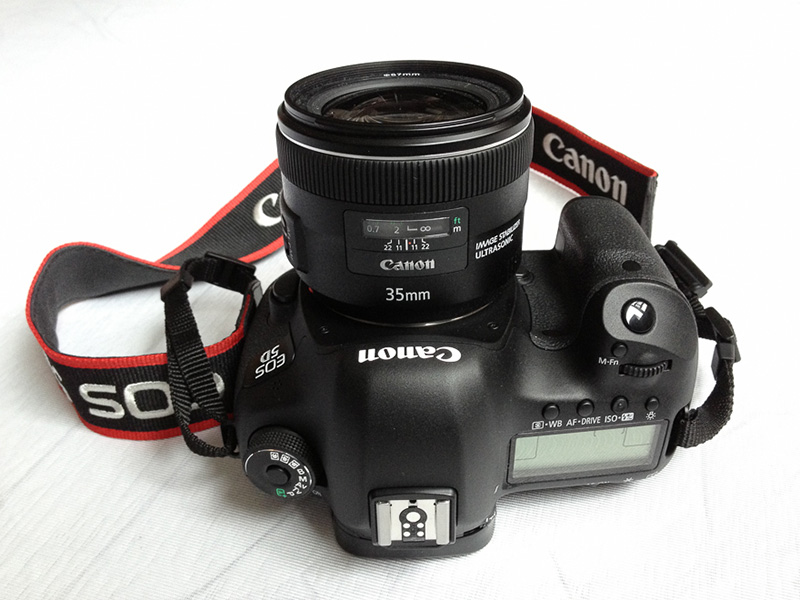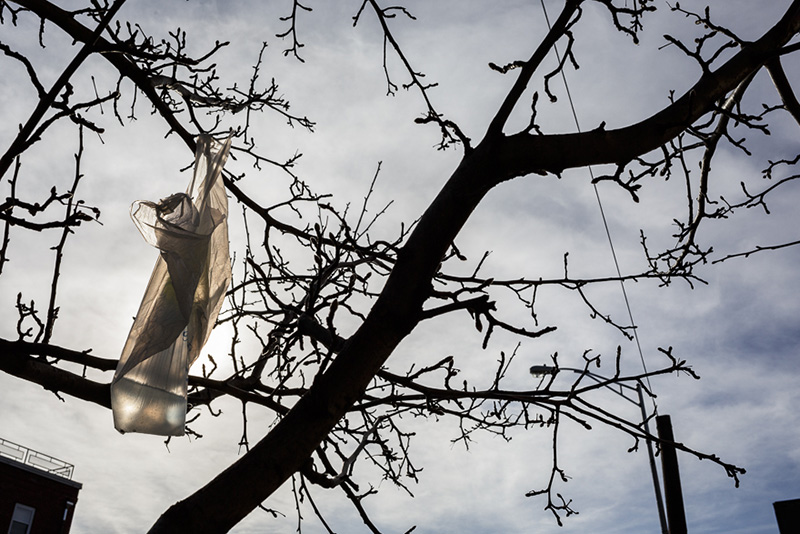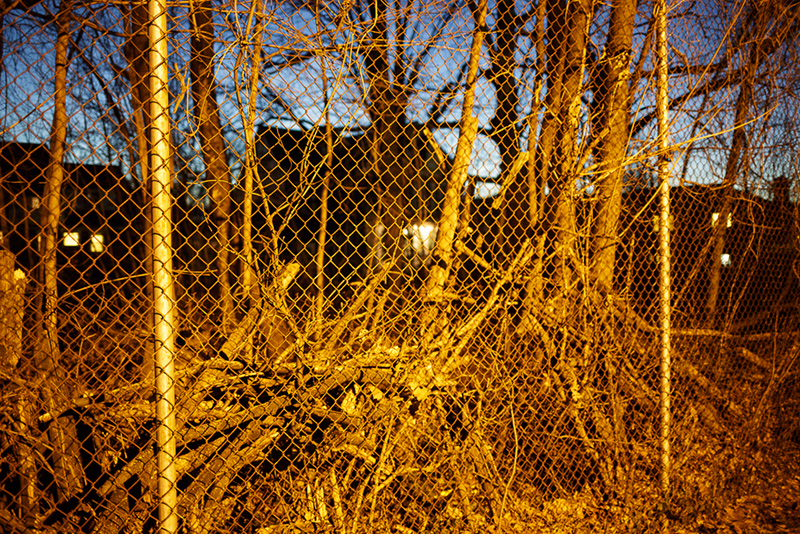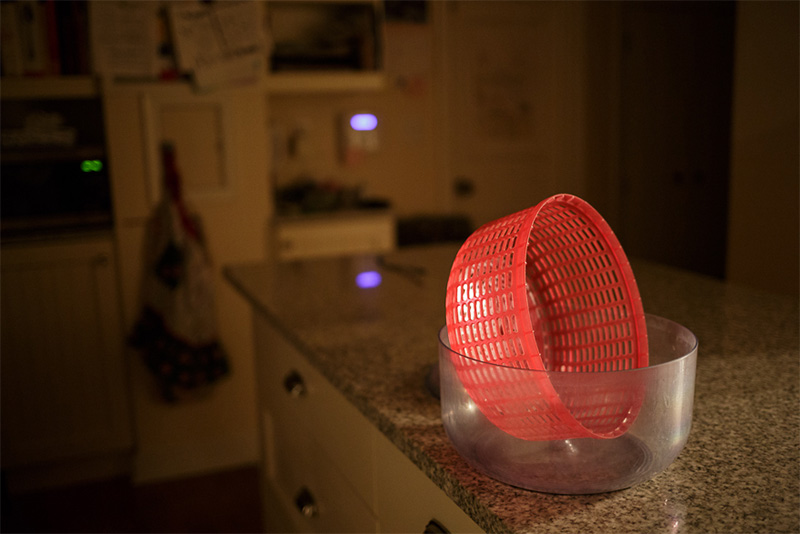
How the world conspired to make me buy a new lens: A review of Canon's new image-stabilized 35mm ƒ/2 lens
By James Leynse
My advice: never get a new camera. I have been happy with the Canon 5D MKII and a collection of shift lenses, zooms, and the Voigtländer 40mm pancake lens. The camera has served me well through almost four years of daily use. For the architectural photography I do for work, the set-up using the shift lenses is just about perfect. With the 40mm lens mounted, the camera is light enough to double as my everyday, "walk about" companion. The only real problem with the MKII is that there is now a MKIII.
This is when the rationalizing begins. My MKII is starting to show its age. It has its fair share of scratches but is still in good working order. I can sell it, while it still retains some trade-in value, and get the new MKIII. When the price of the MKIII dropped a bit with rebates, I took the plunge.
Here I am: brand new MKIII, just like my old MKII but newer and with no scratches. Jokes aside, it is really a great camera: bigger LCD, better implementation of auto bracketing, better autofocusing and (and this was a big plus for me) no increase in megapixels. I appreciate not having to buy a new computer to go with the larger files of a new camera. One major purchase at a time. At least, that was my plan.
As I found out, there is one little inconvenience that comes with all the goodness of the new MKIII. By adding an electronic level and an on-demand grid screen inside the camera's viewfinder (both useful tools when shooting architecture), Canon opted to not allow the focusing screen inside the MKIII to be changed. (Note that you can do so on the newly released Canon 6D.) On my MKII, I had been relying on the replacement Canon Eg-S Super Precision Matte Focusing Screen to manually focus my 40mm Voigtländer. With the new MKIII, that isn't an option. For optical reasons that I can't explain, viewfinder focusing screens can either be bright and easy to see or dark, contrasty (a.k.a. "snappy") and easy to manually focus with. In this day of slow zooms and fast autofocus, most DSLR manufacturers opt for the bright screen option.
Technically, it is still possible to correctly focus the 40mm lens while using the new camera. There is live view or the blinking green dot in the finder which will tell you when the lens is correctly focused. I find both techniques less than ideal when hand-holding a camera. After several weeks of using the MKIII with the 40mm, I had to admit that my hit rate of in-focus shots had dropped significantly. What to do?
 ISO 160, 1/800, ƒ/13. Shooting against the sun, there is virtually no flare
ISO 160, 1/800, ƒ/13. Shooting against the sun, there is virtually no flare
This is where we get to the reason not to buy a new camera and to my review of the new Canon EF 35mm ƒ/2 IS USM lens. (Yes, it is a mouthful.) One new purchase begets another new purchase. What do all all those abbreviations mean? This is an autofocusing (EF) 35mm lens that will fit both full-frame and cropped sensor Canon cameras. It uses Canon's very quiet ultrasonic focusing motor (USM) and has image stabilization (IS) built into the lens. They tweaked the autofocusing so that it works better when being used for video too. It also has a relatively fast maximum aperture of ƒ/2. It sounds like the perfect new companion for my perfect new camera.
My first impression on receiving the lens is that it is a lot larger than the 40mm Voigtländer. The Canon lens takes a 67mm filter vs. the Voigtländer's 52mm. The lens has a much larger profile when mounted on the camera. It is also much larger than Canon's first generation EF 35mm ƒ/2, which this new version will eventually replace. That's the bad news. The good news is that in terms of weight, the difference between it and the Voigtländer is not so great. Thanks to the generous use of plastic, the 35mm weighs a little over four ounces more than the diminutive 40mm. To my hands (and neck) each lens seems to weigh about the same when mounted on a camera.
 An example of the IS at work. Wide open at only 1/4th of a second
An example of the IS at work. Wide open at only 1/4th of a second
There are those who will criticize Canon's use of plastic. I can't really find any fault with this design. There is metal where you need it, on the lens mount, and the plastic used on the barrel seems to be of high quality. There is very little of that plasticky feel here. In fact, the lens seems to be very tightly put together. Unlike the Canon EF 50mm ƒ/1.4 I once owned, nothing shakes when you pick up this lens. The focusing ring is very well damped, almost as smooth as a good manual focus lens. It lacks the weather sealing found on Canon's top-tiered L lenses, but it seems to me that otherwise the new 35mm is up to L lens standards. I would have no problem taking this lens out in the rain.
In fact, I have no problem taking any lens out in the rain. In my twenty years as a photographer, I can remember only one instance (an early Nikon AF zoom) where I had a lens stop working because of the rain. It had gotten a prolonged soaking but it still came back to life after a little drying.
The other "bad" news when it comes to Canon's new 35mm is the price. The old 35mm ƒ/2, which was introduced in 1990 and doesn't offer the quiet USM focusing, now retails for $289 [you have to add it to the cart to see that price —Ed.]. The new 35mm IS USM goes for $849. That's a pretty big jump. If that seems like too much to pay for a 35mm lens, wait six months. The EF 24mm and 28mm ƒ/2.8 IS USM lenses were released last year at the same price as the new 35mm. Both now retail for under $630. It's likely that this new lens will follow the same pattern and the price will come down. It's still a lot to pay for a 35mm ƒ/2 lens; but then, you are getting more for your money.
 Here you can see the vignetting wide open, easily removed in software. Another very slow shutter speed made possible by the IS, 1/5th sec.
Here you can see the vignetting wide open, easily removed in software. Another very slow shutter speed made possible by the IS, 1/5th sec.
Autofocus on the 35mm works like it should: fast and nearly silent. The focusing takes place inside the lens. Nothing moves on the outside. This makes it a lot easier to use filters and other attachments. I haven't done any extensive image quality comparisons with this lens, but I can say that it produces sharp pictures at all apertures. Nothing to complain about in this department. There is some visible vignetting when shooting wide open, and some barrel distortion. Both faults are easily removed in Lightroom or some other types of image-editing software. In fact, this 35mm is almost boring in its demeanor. There is no big, showy front element that screams expensive. The lens just works.
The biggest surprise for me is how effective the image stabilization is on this lens. It's so quiet that I can't tell it's working unless I press my ear against it. Combined with the new high-ISO abilities of the 5D MKIII, I can take pictures in light almost too dim to see by. In fact, it was actually hard to find suitably dark scenes to illustrate the lens's IS ability. For the moment, this might be the best low-light lens around.
 I had difficulty finding examples in my files that were shot in dark enough conditions. This frame, at ƒ/2.2, shows the lens's bokeh
I had difficulty finding examples in my files that were shot in dark enough conditions. This frame, at ƒ/2.2, shows the lens's bokeh
I have long appreciated image stabilization on telephoto lenses. I have Canon's EF 70–300mm ƒ/4–5.6L IS USM lens, and the image stabilization on that lens is a game changer. After a few months of using it, I entirely abandoned my 70–200mm ƒ/2.8. However, I wan't convinced of the need for IS on a wide angle lens. I wan't against it. I just thought that it wasn't necessary. After using this new Canon lens, I have changed my mind.
Canon claims that the IS on this lens gives an extra four stops of usability. That figure might be a bit of a stretch. The effectiveness of IS is hard to quantify and probably varies depending on who is doing the holding and how much coffee or alcohol they have had to drink. Regardless, IS definitely makes a difference here. The old rule-of-thumb (pre-IS) is that a lens can be safely hand-held down to a shutter speed closest to the lens's focal length. Therefore, a 35mm lens could be safely hand-held down to 1/30th of a second. I used to feel that I could reliably shoot a 35mm lens at 1/15th of a second. Using this lens, I am now getting sharp photos at 1/5th of a second. Maybe I could even do 1/2 second if I brace myself. That's not four stops better, but it's a good two stops and maybe more. That two stops improvement in low-light shooting puts this lens ahead of Canon's very good and expensive EF 35mm ƒ/1.4L USM lens and probably on par with the also very expensive EF 24 ƒ/1.4 L USM. Both of those lenses are bigger and heavier than the 35mm IS. Its also easier to get an in-focus shot at ƒ/2 than with the narrow depth-of-field of a lens wide open at ƒ/1.4. Using that logic, I think we have a new winner for "available dark" photography.
That is, until Canon comes out with its all-new EF 50mm IS Super USM ƒ/1 CNTheDRK lens. Even if they do, that lens won’t be for me. I won't be tempted because I am not going to buy a new camera!
James Leynse is an Architectural and Corporate photographer based in New Jersey. His photos can be found at his website, leynse.com.
Links to Amazon U.S., U.K., Germany, and Canada
Original contents copyright 2013 by Michael C. Johnston and/or the bylined author. All Rights Reserved. Links in this post may be to our affiliates; sales through affiliate links may benefit this site.
A book of interest today:
(To see all the comments, click on the "Comments" link below.)
Featured Comments from:
No featured comments yet—please check back soon!




My personal feeling is that the biggest advantage IS gives stills shooters is increased sharpness at marginal--but still normally hand-holdable--shutter speeds, rather than the ability to really drag the shutter.
I'm still waiting to see what coma looks like on the 35 IS before deciding whether it moves into my gear-lust list. C'mon Lenstip, test this puppy!
Posted by: James Sinks | Thursday, 17 January 2013 at 04:28 PM
Lest we all forget -- IS helps with camera motion, but not with subject motion. So whether IS helps you with low-light photography as much as a fast lens depends on your subject (and nearly everybody has some nice static subject, and shoots people or other moving objects other times).
Sounds like James shoots exclusively static subjects; that's unusual, but by no means unheard of.
Posted by: David Dyer-Bennet | Thursday, 17 January 2013 at 04:42 PM
I'm curious if you considered the sigma 35mm f1.4? Maybe too big/heavy...
http://www.lensrentals.com/blog/2012/11/sigma-35mm-f1-4-arrives-announces-new-world-order
Posted by: DH | Thursday, 17 January 2013 at 05:07 PM
James Leynse has a superb portfolio!
Posted by: Sid Lissner | Thursday, 17 January 2013 at 05:28 PM
I saw the title.
I saw the photograph and I read the caption.
My immediate thought was "Jeez Mike! You need to rename this site to "The Phickle Photographer".
Then I read the by-line.
Sorry, Mike.
Good luck with the lens, James.
Posted by: Dave in NM | Thursday, 17 January 2013 at 05:30 PM
Why didn't you just by the new Canon 40mm pancake? It's getting great reviews and it's only $149.
Posted by: Mark | Thursday, 17 January 2013 at 05:37 PM
Enjoyed the review, thanks, and enjoyed looking at your work, especially the portraits.
Posted by: John Krumm | Thursday, 17 January 2013 at 05:53 PM
Thanks for the advice. I've been looking to buy a new camera. Many good candidate bodies these days, but lenses seem to complicate the issue considerably.
Did you test, or even consider, the Canon 40mm pancake? By all accounts an excellent lens and inexpensive, though w/o IS.
Posted by: robert e | Thursday, 17 January 2013 at 05:53 PM
I was interested in this lens, but as I also own an OM-D, I'm going to wait and see the reviews on this -
http://www.metabones.com/images/metabones/Speed%20Booster%20White%20Paper.pdf
Too good to be true? I've got a 50 1.8 I'd love to turn into a 35 1.2
Colin
Posted by: Colin Work | Thursday, 17 January 2013 at 06:07 PM
I think one of the major reasons Canon is bringing out these prime lenses with Image stabilization is for video. This is the main reason to get this lens, if it actually works well while shooting video. No one seems to be testing that in their reviews, which is a shame as I think the ability to shoot video with a shallow DOF and have stability is the major selling point. Yes before you say it this is a Photography site.
Posted by: Richard | Thursday, 17 January 2013 at 06:11 PM
IS is especially valuable for video which is likely the reason it is appearing on more and more of Canon's wide lenses -- EF 24mm, 28mm and 35mm.
Posted by: Speed | Thursday, 17 January 2013 at 06:24 PM
I also have been using the wonderful Voigtlander 40mm chipped for Canon as a walkaround lens on my 5D. Or I was until Canon released its very inexpensive 40mm 2.8. My aging eyes welcome the autofocus, and the Canon is less than half the size of the already diminutive Voigtlander--very much like not having a lens on the camera at all. When I need a true 35, I grab the 1.4 which I still have in my arsenal from fatter times. I can see where an IS F2 would be a very attractive alternative to that lens if the IQ is anywhere near as good.
Posted by: Bill Poole | Thursday, 17 January 2013 at 07:37 PM
I use the Voigtlander 40 mm on a D3 - looks odd but works well - and have grown used to the green dot focus, which is accurate. But it works on a selected focus point. So I just turn on the centre one. Otherwise it gets confused about which point is in focus, and gives false readings.
Posted by: Bear. | Thursday, 17 January 2013 at 08:45 PM
Thanks for the fascinating review, James.
I too was tempted by this new all bells-and-whistles 35 F2 from Canon. I tried it out on a 6D body here in Tokyo and found that it made that body top heavy... It is indeed very large compared to the tiny 35 F2 of old. My own conclusion is that the old, scratchy sounding lens is a terrific bargain, unbeatable at the price, and for me, even better than the 40mm pancake whose AF I find too sluggish on the street.
Posted by: Francis Harrison | Thursday, 17 January 2013 at 09:38 PM
That Green dot works fine on my Nikon, but having IS on a prime. Sweet.
Posted by: Kashapero | Thursday, 17 January 2013 at 09:45 PM
And here I thought I was going to hold out until the 5dmkVi hits the shelves! The 35mm F2 IS is already on my most wanted list, I cannot do without IS, I just love how the IS steadies the camera, and the 40mm pancake will have to go when its faster brother arrives. What really interests me about the MKIII is things like silent shutter and build in spirit levels. I am also an interior and architecture/industrial photographer and a built in spirit level will surely make my life easier....
Posted by: Ivan Muller | Friday, 18 January 2013 at 07:53 AM
I must be the only Canon shooter in existence who doesn't own any IS Canon lenses. And I own and have owned over a dozen Canon EF lenses over the years. Well, actually I DO own one IS lens but it's the 18-55mm kit zoom that came with my T2i. That lens resides on a shelf in the original box--it never gets used and I don't count it.
Not that I discount the functionality of IS. I also shoot Olympus cameras, both micro 4/3 and the original 4/3 SLRs. The cameras all have in-body IS that occasionally comes in handy but has never been a necessity. Canon wants me to buy their IS design every time I buy a new lens. It's a lot extra to pay for something I don't need and only find occasionally handy.
Incidentally, I own the non-IS version of the Canon 35/2 EF lens. While the design may be old and it doesn't have the pizzazz of the new kid in town, the optical quality is excellent.
Posted by: Dogman | Friday, 18 January 2013 at 09:05 AM
I love pancakes. With or without syrup. Can I chip in and say the Canon 40mm f2.8 is a great lens? I use it on FF bodies and have always liked the rather unfashionable focal length. I rabbit on about the 40mm Summicron C here from time to time, and the Sonnar 40mm 2.8 on the Rollei 35 is another gem (IMHO).
I quite like the old 35mm F2, but that new one looks gigantic. What's all the fuss about IS anyway?. DDB made an interesting point. It seems to me that taking pictures in total darkness has become a sort of obsession with folk
(NB Haven't used the Voigtlander, although I use V lenses on other cameras, including the beautiful Bessa III)
Posted by: Richard Tugwell | Friday, 18 January 2013 at 10:46 AM
Argh, just when I was selling all of my canon gear.
Posted by: Hugh Crawford | Friday, 18 January 2013 at 11:24 AM
"It seems to me that taking pictures in total darkness has become a sort of obsession with folk."
Technology has expanded our ability to photograph in lower light levels than ever before. We can photograph more with available light, and we can use less flash. This is a very welcome change.
Posted by: Zlatko Batistich | Friday, 18 January 2013 at 01:39 PM
First off, thanks everyone who read this story and to all who have clicked through to my website. I really appreciate the feedback. I consider compliments from the discerning readership of TOP to be very high praise. I am going to try to answer some of the questions raised here in the comments.
"Why didn't you just buy the new Canon 40mm pancake?"-- I thought about that lens but it seemed seemed redundant since I already have the faster Voigtländer. It's got to be the best bargain in Canon's lens lineup, however.
"I'm curious if you considered the sigma 35mm f1.4?" -- It looks good from what I have read but it is a much bigger lens and I have had some bad experiences in the past with Sigma lenses.
"I think one of the major reasons Canon is bringing out these prime lenses with Image stabilization is for video."-- I totally agree with this. I don't shoot much video yet but am starting to do some for my stock agency so this would be a bonus. I still feel that IS is not absolutely necessary in a lens of this focal length but it sure is nice to have it.
Thanks to all who have commented. James
Posted by: James Leynse | Friday, 18 January 2013 at 03:58 PM
Sounds like a great lens, but what I really want is that cool red lettuce spinner!
Posted by: Rob Atkins | Friday, 18 January 2013 at 04:29 PM
I hope that either the classic 35/2 is kept in the line-up, or the price of the new 35/2 drops to sane levels. A line-up replacement shouldn't cost 2.5 times the original. USM and IS aren't exactly cutting-edge technologies that require a big markup to recoup R&D costs.
Posted by: matt | Friday, 18 January 2013 at 05:28 PM
I had been watching the prices for the older 35 f2 (without IS) on eBay. After this article hit, the prices took a bit of a jump upward, and the bidding has gotten a lot faster. Used and refurb lenses are selling for almost what a new one costs now.....sheesh. Thanks for all of the great photography conversations, but this site can kill a good deal in seconds, literally. :)
Posted by: Richard | Sunday, 20 January 2013 at 09:24 PM